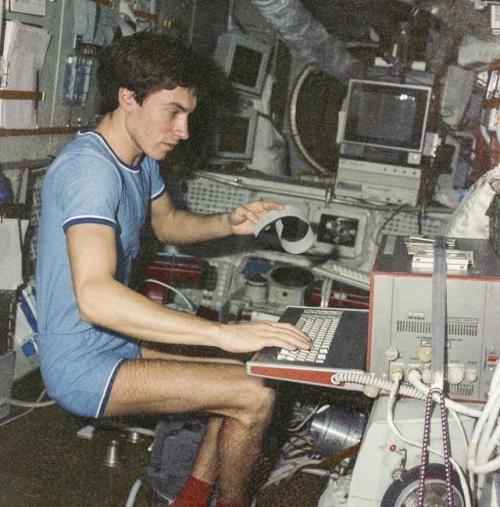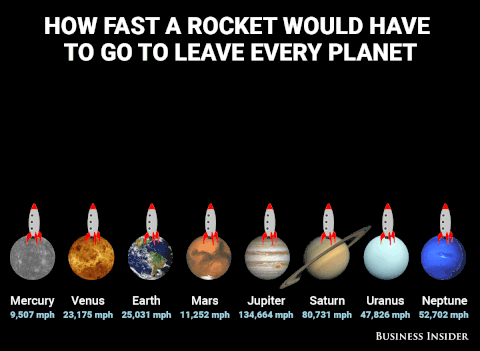Fillthevoid-with-space - Fill The Void With... SPACE

More Posts from Fillthevoid-with-space and Others

Bright Spiral Galaxy M81 : One of the brightest galaxies in planet Earths sky is similar in size to our Milky Way Galaxy: big, beautiful M81. This grand spiral galaxy can be found toward the northern constellation of the Great Bear . This superbly detailed view reveals M81s bright yellow nucleus, blue spiral arms, and sweeping cosmic dust lanes with a scale comparable to the Milky Way. Hinting at a disorderly past, a remarkable dust lane actually runs straight through the disk, to the left of the galactic center, contrary to M81s other prominent spiral features. The errant dust lane may be the lingering result of a close encounter between M81 and its smaller companion galaxy, M82. Scrutiny of variable stars in M81 has yielded one of the best determined distances for an external galaxy 11.8 million light-years. via NASA
js










Meet SA-500D, the first Saturn V rocket. Wernher von Braun designed her as the dynamic test article for the program. She was assembled stage by stage inside the Dynamic Test Stand at NASA Marshall Spaceflight Center, then subjected to lateral, longitudinal, and torsional vibrations equal of that of launch for a total of 450 hours.
The first time I visited SA-500D in 1999, she was outside on the US Space and Rocket Center property. Her paint was faded and worn, having sat there since 1969. In 2005, full restoration began, and she was moved inside her new facility, the Davidson Center for Space Exploration in Huntsville, Alabama. I’m happy to report that as of Sunday, April 27, 2014, she looks great. Viewing the newly restored rocket is magnitudes more impactful. The difference is incredible.
What was the hardest part in training to go to space?
One of the most challenging parts of space training was learning how to use the space suit. We weigh over 400 pounds in the space suit, and since it is pressurized, each movement of your hands is like working against an exercise ball. Since the suit needs to be quite bulky in order to protect us from the environment of space (vacuum, radiation, micrometeoroids, extreme temperature) while doing a spacewalk, it makes body movements a bit awkward. Dexterity is quite compromised with the bulky gloves as well. Although it is challenging, however, it is likely also the most rewarding, because, well, you are in a SPACE SUIT!!! Hopefully I’ll get to do a spacewalk and look down on the our planet from above on a mission to the International Space Station in a few years.
What are the most important skills an astronaut should have m?
First of all, the basic requirement is a bachelor’s degree in a STEM field, and 3 years of experience (which can also be substituted for by an advanced degree). Other than that, operational experience (things with a technical/active/hands on nature like flying airplanes, SCUBA diving, taking things apart and putting them back together, basic fix-it skills, etc. etc.) is very important, as this is an integral aspect of every day of a space mission. What we call “expeditionary skills” are also essential, basically the types of things you try to instill in your children, like how to play nicely with others, self care, team care, etc. I like to think about this on the lines of a camping trip and who you would like to have along with you …someone that is competent and can take good care of themselves and their equipment, someone that contributes to the team and helps with group tasks, someone that is good natured and pleasant to be around, etc., someone fun! These things are increasingly important now that we are regularly doing long duration missions (typical International Space Station mission is 6 months). Experience living in extreme/remote/isolated environments with small teams is also useful, as it is similar to what we experience as astronauts.

NASA has emailed a wrench to astronauts in space
Responding to International Space Station (ISS) astronauts’ need for a wrench, NASA solved the problem by emailing a digital file to the ISS. The astronauts then 3D-printed the tool.
In a post on Backchannel, Mike Chen, founder of Made In Space, explained how the process worked.Made in Space is a Silicon Valley startup that built the 3D printer that was shipped to the ISS in September. In November, the first-ever 3D-printed part was, yes, made in space.
“My colleagues and I just 3D-printed a ratcheting socket wrench on the International Space Station by typing some commands on our computer in California,” Chen wrote in his post. “We had overheard ISS Commander Barry Wilmore … mention over the radio that he needed one, so we designed one in CAD and sent it up to him faster than a rocket ever could have. This is the first time we’ve ever ‘emailed’ hardware to space.”

TODAY IN HISTORY: The first-ever color image of Mars, taken by NASA’s Viking 1 lander on July 21, 1976. (San Diego Air & Space Museum)

Great detail of the famous crawler that transported the mighty Saturn V and all the space shuttles to the launch pads. An engineering feat in its own right.

Soviet Cosmonaut Sergei Krikalev stuck in space during the collapse of the Soviet Union in 1991
Unable to return home, he ended up having to stay in space until further notice.
The cosmonaut eventually returned back to earth on March 25, 1992, after 10 months in orbit - to a nation that was very different to what it was when he had left. The Soviet Union had fractured into 15 nations, presidents had changed, and even his hometown of Leningrad had become St. Petersburg.
Interestingly, at the time, Krikalev was supposed to serve in the military reserves, and was almost issued a warrant for desertion – before the army realised that their reserve soldier was not even on the planet.
-
 totallybooks liked this · 2 years ago
totallybooks liked this · 2 years ago -
 impressivebiscuit liked this · 2 years ago
impressivebiscuit liked this · 2 years ago -
 wrennette reblogged this · 2 years ago
wrennette reblogged this · 2 years ago -
 camdennightingale reblogged this · 2 years ago
camdennightingale reblogged this · 2 years ago -
 camdennightingale liked this · 2 years ago
camdennightingale liked this · 2 years ago -
 strugglingqueer liked this · 2 years ago
strugglingqueer liked this · 2 years ago -
 itsjustalittlevampire liked this · 2 years ago
itsjustalittlevampire liked this · 2 years ago -
 sub-at-omicsteminist liked this · 2 years ago
sub-at-omicsteminist liked this · 2 years ago -
 anaroacephysicist reblogged this · 2 years ago
anaroacephysicist reblogged this · 2 years ago -
 rebeccaistrans reblogged this · 2 years ago
rebeccaistrans reblogged this · 2 years ago -
 faith-in-nonsense liked this · 2 years ago
faith-in-nonsense liked this · 2 years ago -
 faith-in-nonsense reblogged this · 2 years ago
faith-in-nonsense reblogged this · 2 years ago -
 merlyn-bane reblogged this · 2 years ago
merlyn-bane reblogged this · 2 years ago -
 merlyn-bane liked this · 2 years ago
merlyn-bane liked this · 2 years ago -
 wrennette liked this · 2 years ago
wrennette liked this · 2 years ago -
 lttrsfrmlnrrgby reblogged this · 2 years ago
lttrsfrmlnrrgby reblogged this · 2 years ago -
 sirsnortsalot liked this · 2 years ago
sirsnortsalot liked this · 2 years ago -
 folklouire liked this · 2 years ago
folklouire liked this · 2 years ago -
 rebeccaistrans reblogged this · 2 years ago
rebeccaistrans reblogged this · 2 years ago -
 robinwaaaaa liked this · 2 years ago
robinwaaaaa liked this · 2 years ago -
 l3monivy reblogged this · 2 years ago
l3monivy reblogged this · 2 years ago -
 l3monivy liked this · 2 years ago
l3monivy liked this · 2 years ago -
 suscedes liked this · 2 years ago
suscedes liked this · 2 years ago -
 cowboyliketeddy liked this · 2 years ago
cowboyliketeddy liked this · 2 years ago -
 sparklezfallsinlovewithbooks reblogged this · 2 years ago
sparklezfallsinlovewithbooks reblogged this · 2 years ago -
 sparklezfallsinlovewithbooks liked this · 2 years ago
sparklezfallsinlovewithbooks liked this · 2 years ago -
 graciebrams liked this · 2 years ago
graciebrams liked this · 2 years ago -
 662607015 liked this · 2 years ago
662607015 liked this · 2 years ago -
 therealdostoevsky liked this · 2 years ago
therealdostoevsky liked this · 2 years ago -
 pubwegf reblogged this · 2 years ago
pubwegf reblogged this · 2 years ago -
 pubwegf liked this · 2 years ago
pubwegf liked this · 2 years ago -
 dietlemonadee liked this · 2 years ago
dietlemonadee liked this · 2 years ago -
 graveyarrdshift reblogged this · 2 years ago
graveyarrdshift reblogged this · 2 years ago -
 graveyarrdshift liked this · 2 years ago
graveyarrdshift liked this · 2 years ago -
 theone reblogged this · 2 years ago
theone reblogged this · 2 years ago -
 theone liked this · 2 years ago
theone liked this · 2 years ago -
 bingbongifuckedurmom reblogged this · 2 years ago
bingbongifuckedurmom reblogged this · 2 years ago -
 booksnscience liked this · 2 years ago
booksnscience liked this · 2 years ago -
 startingfires reblogged this · 2 years ago
startingfires reblogged this · 2 years ago -
 startingfires liked this · 2 years ago
startingfires liked this · 2 years ago -
 anaroacephysicist reblogged this · 2 years ago
anaroacephysicist reblogged this · 2 years ago -
 pavelbelyayev reblogged this · 2 years ago
pavelbelyayev reblogged this · 2 years ago -
 w1zardcore liked this · 2 years ago
w1zardcore liked this · 2 years ago -
 universe-unwinding reblogged this · 2 years ago
universe-unwinding reblogged this · 2 years ago
A podcast project to fill the space in my heart and my time that used to be filled with academic research. In 2018, that space gets filled with... MORE SPACE! Cheerfully researched, painstakingly edited, informal as hell, definitely worth everyone's time.
243 posts

